Roast Duck with Orange Glaze is a dish that combines rich, savory meat with the bright sweetness of citrus. The duck is roasted until the skin is perfectly crisp and golden, while the meat remains tender and juicy. The orange glaze adds a glossy finish and a burst of flavor that balances the richness of the duck. This classic dish, inspired by French cuisine, is both elegant and comforting — a perfect centerpiece for holidays, dinner parties, or any special occasion.
This recipe celebrates the harmony of contrasting flavors and textures. The duck’s natural fat renders during roasting, creating a crisp exterior, while the orange glaze adds a sweet-tart note that enhances every bite. The result is a dish that’s indulgent yet refined, simple yet impressive.
The Essence of Roast Duck with Orange Glaze
The essence of this dish lies in the balance between richness and brightness. Duck has a deep, savory flavor and a layer of fat that, when rendered properly, creates a crisp, golden skin. The orange glaze, made with fresh juice, zest, and a touch of sweetness, cuts through the richness and adds a refreshing contrast. Together, they create a dish that’s both luxurious and perfectly balanced.
It’s a recipe that embodies sophistication and comfort — a timeless classic that never fails to impress.
Why This Recipe Works
This recipe works because it focuses on technique and balance. Scoring the duck skin allows the fat to render evenly, resulting in crisp skin and tender meat. The orange glaze, made with citrus, honey, and vinegar, adds depth and brightness without overpowering the duck’s natural flavor. Roasting at the right temperature ensures even cooking and a beautiful golden finish.
The result is a dish that’s flavorful, aromatic, and visually stunning — a true centerpiece for any table.
Ingredients and Their Roles
Whole duck: The star of the dish, providing rich, flavorful meat and crisp skin.
Oranges: Provide juice and zest for the glaze, adding sweetness and acidity.
Honey: Adds sweetness and helps the glaze caramelize.
Soy sauce: Adds umami and depth to the glaze.
Vinegar: Balances the sweetness with acidity.
Garlic and ginger: Add aromatic warmth and complexity.
Salt and pepper: Essential for seasoning and enhancing flavor.
Step-by-Step Recipe
Ingredients
- 1 whole duck (5–6 lbs)
- 2 oranges (zested and juiced)
- 3 tablespoons honey
- 2 tablespoons soy sauce
- 1 tablespoon rice vinegar or white wine vinegar
- 2 garlic cloves, minced
- 1 teaspoon grated fresh ginger
- Salt and freshly ground black pepper
Preparation
- Preheat the oven. Set the oven to 375°F (190°C). Place a rack in a roasting pan.
- Prepare the duck. Remove any giblets and pat the duck dry with paper towels. Trim excess fat from the cavity. Using a sharp knife, score the skin in a crosshatch pattern, being careful not to cut into the meat. Season generously with salt and pepper inside and out.
- Roast the duck. Place the duck breast-side up on the rack. Roast for 1 hour, then carefully drain the rendered fat from the pan. Flip the duck and roast for another 30 minutes.
- Make the orange glaze. In a small saucepan, combine orange juice, zest, honey, soy sauce, vinegar, garlic, and ginger. Bring to a simmer over medium heat and cook until slightly thickened, about 10 minutes.
- Glaze and finish roasting. Flip the duck breast-side up again. Brush generously with the orange glaze and roast for another 20–30 minutes, basting every 10 minutes, until the skin is golden and crisp. The internal temperature should reach 165°F (74°C).
- Rest and serve. Let the duck rest for 15 minutes before carving. Serve with extra glaze on the side.
Tips for Perfect Roast Duck
- Score the skin to help the fat render evenly.
- Pat the duck dry before roasting for crisp skin.
- Drain the fat periodically to prevent smoking.
- Use a rack to allow air circulation and even cooking.
- Rest the duck before carving to retain juices.
Variations and Flavor Combinations
1. Classic Orange Glazed Duck
Traditional version with orange juice, honey, and soy sauce.
2. Spicy Orange Duck
Add chili flakes or sriracha to the glaze for heat.
3. Maple Glazed Duck
Replace honey with maple syrup for a deeper sweetness.
4. Ginger Orange Duck
Add extra ginger for a bold, aromatic flavor.
5. Balsamic Orange Duck
Add a splash of balsamic vinegar for a tangy twist.
6. Herb-Infused Duck
Add rosemary or thyme to the glaze for an herbal note.
Serving Suggestions
Roast Duck with Orange Glaze pairs beautifully with:
- Roasted or mashed potatoes.
- Wild rice or couscous.
- Steamed green beans or asparagus.
- A crisp green salad with citrus dressing.
- A glass of Pinot Noir or Zinfandel.
It’s perfect for:
- Christmas or New Year’s dinners.
- Romantic dinners.
- Holiday celebrations.
- Elegant dinner parties.
Make-Ahead and Storage
Make-ahead: Prepare the glaze up to 2 days in advance and refrigerate. Warm before using.
Storage: Store leftover duck in an airtight container in the refrigerator for up to 3 days.
Freezing: Freeze cooked duck pieces for up to 2 months. Thaw overnight in the refrigerator before reheating.
Reheating: Reheat in the oven at 350°F (175°C) for 10–15 minutes until warm and crisp.
Nutritional Information (per serving)**
- Calories: 480 kcal
- Protein: 35 g
- Fat: 32 g
- Carbohydrates: 12 g
- Fiber: 0 g
The History of Duck à l’Orange
Duck à l’Orange, the inspiration for this dish, originated in France and became a symbol of fine dining in the 19th century. The combination of rich duck and bright citrus sauce reflected the French mastery of balancing flavors. Over time, the dish spread across Europe and beyond, becoming a holiday favorite for its elegance and flavor.
Today, Roast Duck with Orange Glaze remains a beloved classic, blending tradition with modern simplicity.
Texture and Flavor Profile
The perfect roast duck is crisp on the outside and tender inside. The rendered fat creates a golden, crackling skin, while the meat stays juicy and flavorful. The orange glaze adds a glossy finish and a balance of sweet, tangy, and savory notes.
Each bite delivers a contrast of textures and flavors — crispy, tender, sweet, and savory — making it both satisfying and refined.
Common Mistakes and How to Avoid Them
Not scoring the skin: Prevents fat from rendering properly.
Skipping the drying step: Moisture prevents crispness.
Overcooking: Can make the meat tough. Use a thermometer.
Not draining fat: Causes smoking and uneven cooking.
Applying glaze too early: Can cause burning. Add glaze near the end.
Chef’s Tips
- Save the rendered duck fat for roasting potatoes or vegetables.
- Add a splash of Grand Marnier or orange liqueur to the glaze for depth.
- Use fresh orange juice for the best flavor.
- Garnish with orange slices or zest for presentation.
- Serve with a side of cranberry or cherry sauce for contrast.
Pairing Ideas
With Drinks:
- Pinot Noir or Merlot for a balanced pairing.
- Riesling or Chenin Blanc for a sweet contrast.
- Sparkling wine for a festive touch.
With Other Dishes:
- Pair with roasted root vegetables or Brussels sprouts.
- Serve alongside wild rice pilaf or couscous.
- Add to a holiday spread with salads and sides.
The Joy of Holiday Cooking
Roast Duck with Orange Glaze embodies the joy of holiday cooking — the aroma of citrus and roasted duck filling the kitchen, the golden skin emerging from the oven, and the anticipation of carving into a perfectly cooked bird. It’s a dish that brings people together, symbolizing warmth, celebration, and indulgence.
It’s proof that elegance can be achieved with simple ingredients and thoughtful preparation.
The Science of Crisp Skin
The secret to crisp duck skin lies in rendering the fat. Scoring the skin allows the fat to melt and baste the meat as it cooks. Roasting at the right temperature ensures the skin becomes golden and crisp without burning. The final glaze adds shine and flavor, creating a perfect balance of texture and taste.
Presentation and Finishing Touches
For an elegant presentation, carve the duck and arrange the slices on a platter. Drizzle with orange glaze and garnish with fresh orange slices and herbs. For a rustic look, serve the whole duck on a wooden board for carving at the table.
For a festive touch, add pomegranate seeds or roasted citrus halves around the platter.
Modern Variations
- Keto Version: Use sugar-free honey or sweetener in the glaze.
- Gluten-Free Version: Naturally gluten-free.
- Dairy-Free Version: Naturally dairy-free.
- Low-Sodium Version: Use low-sodium soy sauce.
- Gourmet Version: Add truffle honey or orange liqueur for luxury.
The Perfect Centerpiece
Roast Duck with Orange Glaze is the perfect centerpiece for any celebration. It’s impressive yet approachable, rich yet balanced. Its golden skin and glossy glaze make it a highlight of any holiday table, ensuring it’s remembered long after the meal is over.
The Cultural Influence of Duck and Citrus
Duck and citrus have long been paired in European and Asian cuisines. The richness of duck complements the brightness of citrus, creating a timeless flavor combination. This dish reflects that harmony, blending French tradition with modern simplicity.
The Role of Citrus and Honey
Citrus adds freshness and acidity, while honey provides sweetness and caramelization. Together, they create a glaze that enhances the duck’s flavor and gives it a beautiful sheen. The balance of sweet and tangy is what makes this dish unforgettable.
The Perfect Bite
The perfect bite of roast duck with orange glaze combines crisp skin, tender meat, and a glossy, citrusy coating. It’s rich, balanced, and full of flavor — a bite that captures the essence of festive dining.
Conclusion
Roast Duck with Orange Glaze is a celebration of flavor, texture, and tradition. With its crispy skin, tender meat, and bright citrus glaze, it’s a dish that feels both luxurious and comforting.
Easy to prepare yet impressive to serve, it’s perfect for any festive occasion. This recipe proves that with a few simple ingredients and a touch of care, you can create a centerpiece that’s both beautiful and unforgettable — a timeless classic of elegant cooking.







